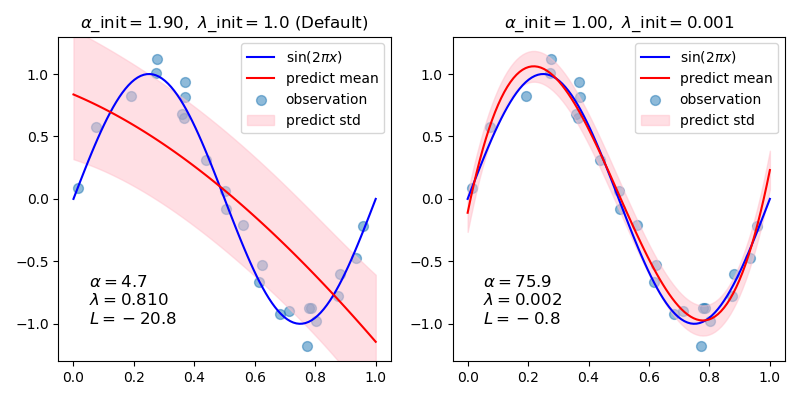基于贝叶斯岭回归的曲线拟合¶
计算正弦波的贝叶斯岭回归。
有关回归的更多信息,请参见 Bayesian Ridge Regression。
一般来说,在用贝叶斯岭回归拟合多项式曲线时,正则化参数(α,lambda)的初始值的选择可能是重要的。这是因为正则化参数是由依赖于初始值的迭代过程确定的。
在这个例子中,正弦波用多项式逼近,使用不同的初始值。
当从默认值(alpha_init=1.90,lambda_init=1.)开始时,结果曲线的偏差很大,而方差很小。因此,lambda_init应该设置相对较小的(1.e-3),以减少偏差。
此外,通过评估这些模型的对数边际似然(L),我们可以确定哪一种更好。可以得出结论,L较大的模型更有可能。

print(__doc__)
# Author: Yoshihiro Uchida <nimbus1after2a1sun7shower@gmail.com>
import numpy as np
import matplotlib.pyplot as plt
from sklearn.linear_model import BayesianRidge
def func(x): return np.sin(2*np.pi*x)
# #############################################################################
# Generate sinusoidal data with noise
size = 25
rng = np.random.RandomState(1234)
x_train = rng.uniform(0., 1., size)
y_train = func(x_train) + rng.normal(scale=0.1, size=size)
x_test = np.linspace(0., 1., 100)
# #############################################################################
# Fit by cubic polynomial
n_order = 3
X_train = np.vander(x_train, n_order + 1, increasing=True)
X_test = np.vander(x_test, n_order + 1, increasing=True)
# #############################################################################
# Plot the true and predicted curves with log marginal likelihood (L)
reg = BayesianRidge(tol=1e-6, fit_intercept=False, compute_score=True)
fig, axes = plt.subplots(1, 2, figsize=(8, 4))
for i, ax in enumerate(axes):
# Bayesian ridge regression with different initial value pairs
if i == 0:
init = [1 / np.var(y_train), 1.] # Default values
elif i == 1:
init = [1., 1e-3]
reg.set_params(alpha_init=init[0], lambda_init=init[1])
reg.fit(X_train, y_train)
ymean, ystd = reg.predict(X_test, return_std=True)
ax.plot(x_test, func(x_test), color="blue", label="sin($2\\pi x$)")
ax.scatter(x_train, y_train, s=50, alpha=0.5, label="observation")
ax.plot(x_test, ymean, color="red", label="predict mean")
ax.fill_between(x_test, ymean-ystd, ymean+ystd,
color="pink", alpha=0.5, label="predict std")
ax.set_ylim(-1.3, 1.3)
ax.legend()
title = "$\\alpha$_init$={:.2f},\\ \\lambda$_init$={}$".format(
init[0], init[1])
if i == 0:
title += " (Default)"
ax.set_title(title, fontsize=12)
text = "$\\alpha={:.1f}$\n$\\lambda={:.3f}$\n$L={:.1f}$".format(
reg.alpha_, reg.lambda_, reg.scores_[-1])
ax.text(0.05, -1.0, text, fontsize=12)
plt.tight_layout()
plt.show()
脚本的总运行时间:(0分0.252秒)
Download Python source code: plot_bayesian_ridge_curvefit.py
Download Jupyter notebook:plot_bayesian_ridge_curvefit.ipynb




